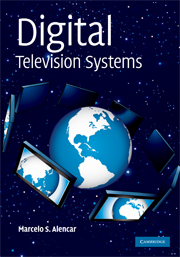Book contents
- Frontmatter
- Contents
- List of figures
- List of tables
- List of contributors
- Preface
- Acknowledgments
- 1 Fundamentals of digital television
- 2 Audio and video coding
- 3 Fundamentals and standards of video and audio compression
- 4 Channel coding for digital television
- 5 Digital and analog transmission systems
- 6 Advanced Television Systems Committee standard (ATSC)
- 7 Digital video broadcasting (DVB)
- 8 International Services Digital Broadcasting for Terrestrial Television Broadcasting (ISDB)
- 9 International System for Digital Television (ISDTV)
- 10 Digital terrestrial television multimedia broadcasting (DTMB)
- Appendix A Evolution of television standards
- Appendix B Signal analysis
- Appendix C Random signals and noise
- Glossary
- References
- Index
10 - Digital terrestrial television multimedia broadcasting (DTMB)
Published online by Cambridge University Press: 28 January 2010
- Frontmatter
- Contents
- List of figures
- List of tables
- List of contributors
- Preface
- Acknowledgments
- 1 Fundamentals of digital television
- 2 Audio and video coding
- 3 Fundamentals and standards of video and audio compression
- 4 Channel coding for digital television
- 5 Digital and analog transmission systems
- 6 Advanced Television Systems Committee standard (ATSC)
- 7 Digital video broadcasting (DVB)
- 8 International Services Digital Broadcasting for Terrestrial Television Broadcasting (ISDB)
- 9 International System for Digital Television (ISDTV)
- 10 Digital terrestrial television multimedia broadcasting (DTMB)
- Appendix A Evolution of television standards
- Appendix B Signal analysis
- Appendix C Random signals and noise
- Glossary
- References
- Index
Summary
Introduction
China has the world's largest population of electronics consumers. There are currently more than 400 million television sets in China, which represents around 30% of all television sets worldwide. Like other developing countries, China decided to develop its own standard in order to avoid having to pay licensing fees. Both the US and the European digital television systems, for example, depend on patented technology. Although paying to use that technology may not represent much in more developed countries, it is certainly an important issue for China. Adapting the digital television technology to the local reality is also an important reason for developing a national standard.
Efforts to develop China's digital television standard started in 1994. In 1995, the government created the high-definition television (HDTV) Technical Executive Experts Group (TEEG), with members from the research community. The first HDTV prototype was developed three years later. It included a high-definition encoder and decoder, as well as a multiplexer, a modulator, a demodulator, and a demultiplexer. This system was used to broadcast a live program celebrating the 50th National Anniversary Day in 1999. In 2001, the government started to accept proposals for a digital terrestrial television broadcasting standard. In order to evaluate the suitability of the proposals for the Chinese market, laboratory and field tests were performed, along with intellectual property analysis. Three of the submitted proposals were chosen:
Advanced Digital Television Broadcasting – Terrestrial (ADTB-T): a single-carrier approach from HDTV TEEG.
Digital Multimedia Broadcasting – Terrestrial (DMB-T): a multicarrier approach from Tsinghua University.
Terrestrial Interactive Multiservice Infrastructure (TiMi): a multicarrier approach, proposed by the Academy of Broadcasting Science.
- Type
- Chapter
- Information
- Digital Television Systems , pp. 202 - 212Publisher: Cambridge University PressPrint publication year: 2009



